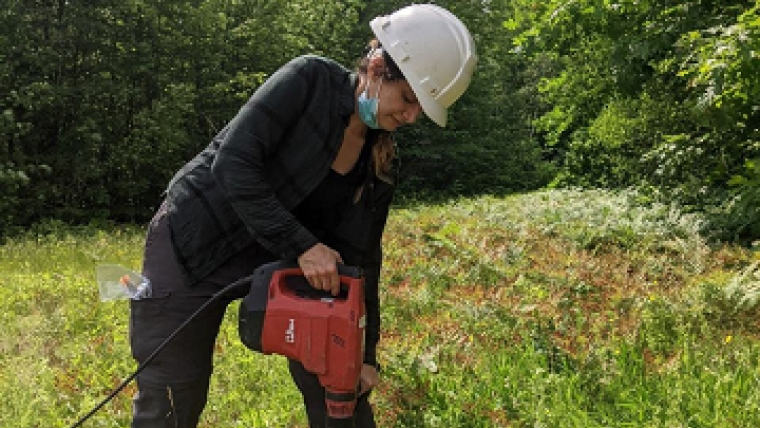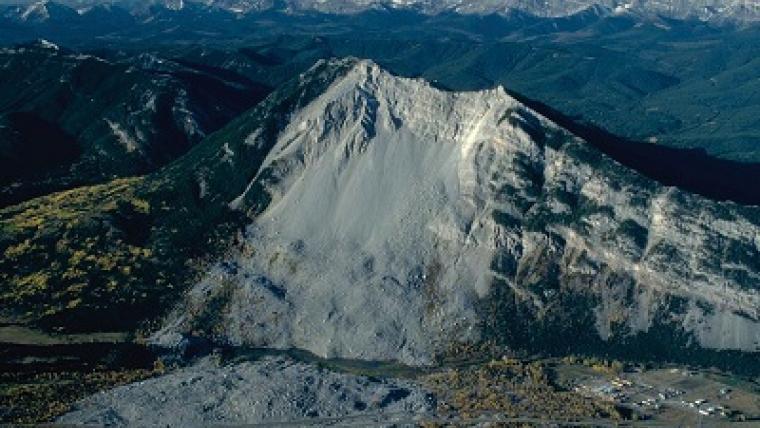Incorporating Artificial Intelligence (Ask NRcan)
Like many organizations, the Government of Canada is exploring ways to incorporate artificial intelligence into our work to make us more efficient and effective. On this episode, we’ll learn what artificial intelligence is, and we’ll see how it can be used to solve problems that the natural resource sectors are facing.
Transcript
– Joel Houle
Welcome, everyone, to Ask NRCan. I'm your host, Joel Houle, and this is our podcast series where we sit down with our experts to talk about the work that we do here at Natural Resources Canada, or NRCan for short.
Like many organizations, our department is exploring ways to incorporate artificial intelligence into our work to make us more efficient and effective. On this episode, we'll learn what artificial intelligence is and we'll see how it can be used to solve problems that the natural resource sectors are facing.
If you're new to the show, we call the series Ask NRCan because we want to hear from you and learn what interests you about the world around us. With Ask NRCan, we discuss the type of science that we do and also why we do it. So at the end of the episode, if you have any questions on today's topic, or on science in general, head to Twitter and tweet at us using the hashtag AskNRCan. Our experts will do their best to answer all your questions. We usually release an episode of Ask NRCan on the first Tuesday of each month. So make sure to subscribe so you don't miss an episode. Okay, let's meet our guest.
– Joel Houle
Our guest is policy expert Jack Jensen from the Innovation and Energy Technology Sector. Jack, thank you for joining us.
– Jack Jensen
Thanks for having me.
– Joel Houle
So when I hear the term artificial intelligence, or A.I. — and this probably explains why I'm the one asking the questions and not answering them — but when I think about A.I., I think of Skynet from the Terminator movies and the A.I. system that becomes self-aware and turns on humanity. Can you start by explaining to me what exactly is A.I.?
– Jack Jensen
I can try. I mean it's sort of become a bit of an umbrella term to mean a lot of things. But the truth is that A.I. is really any system that uses data to make a prediction, and that prediction can be used for all kinds of things: it can be used for automated vehicles, it can be used to identify patterns, to produce insights, to control things, to enhance the work that we do. And then, if you take that a step further, sure you get machines that think for themselves and can create themselves and turn into batteries.
– Joel Houle
So there's a big leap between an algorithm and the A.I. that we see in the movies, I guess, right?
– Jack Jensen
Yeah. And I mean the A.I. of today is a little bit different than the A.I. of 20 years ago, right? You can look back to research papers from 20 years ago, and A.I. might mean something that today we would call, you know, a form of structured learning or an expert machine. So it really has evolved quite a lot. And what A.I. can do now in terms of making correlations and identifying patterns is far beyond what was ever possible previously.
– Joel Houle
What's your role here at NRCan, and how does it relate to A.I.?
– Jack Jensen
Well my role is to steer a team that thinks about digital at NRCan and where our pockets of expertise are and how we can help the department do more with data analytics, artificial intelligence and digital transformation. So we need skills, we need infrastructure, we need people to have access to the data and tools to do their work. And it really applies to a whole bunch of different areas: our business, like our procurement and how we hire people, all the way through to our science — which, I think, are some of the more exciting applications for artificial intelligence. And my role is to sort of understand that and to help generate more understanding for executives and the public and to make links between some of what's going on in our work and what we could be doing.
– Joel Houle
What has NRCan been doing to understand A.I. and how it fits into our work?
– Jack Jensen
At the researcher level, they've been using artificial intelligence and looking at that question as part of their career forever. So at the individual level we've been doing a lot of that.
But at a corporate level, we've been trying to understand the ecosystem of artificial intelligence at the department, because we do work a little bit as individuals, not as much of an organized collective as you might think. So we're trying to understand who's doing what projects in artificial intelligence; who they're collaborating with; what more we could do to help them in terms of access to data, working with others in Canada or externally; and even things like how we think about cybersecurity and intellectual property when it comes to our data and artificial intelligence. Because those are questions that from an individual researcher's perspective, for example, might not be that interesting, but they could really add value when you think of it from a systems point of view.
– Joel Houle
Are there any NRCan specific projects that currently use A.I.?
– Jack Jensen
Oh yeah. I mean it's hard to put a number on it. We did a short snapshot in time of A.I. projects, about last year at this time, and we identified 40 or so, and they're in different phases of development. So you know, some of them you could think of a little bit as conceptual, and others are quite well advanced.
But some of them are pretty cool. A.I. for forest fire weather prediction, for example, to help with forest fires and emergency preparedness. The same thing goes for earthquake prediction. So we're definitely working in those areas, which to me are some of the really publicly visible applications.
You might also think of the mapping exercise as really exciting. We're working on a project right now through the Geological Survey of Canada that uses aerial imagery to create automated maps — so, basically, maps that map themselves. If you were to ask an expert cartographer to do it by hand, mapping, for example, the city of Kingston could take months and months. But using algorithms to identify patterns that would then say, “oh this is a road,” or “this is a waterway,” or “this is a house” can do it much, much, much faster and with equal or better accuracy, which is really cool.
And that application can be used for all kinds of things. The number of examples that you might see in NRCan work are things that you can see in real life everyday. I mean, people hear about smart grid, for example, and don't really know how a smart grid works. And a smart grid relies entirely almost on data. So people need to use electricity and energy; industries do, businesses do, individuals do. Ultimately, the goal of a smart grid is to balance what we want to use and what we can produce, and to make a decision on cost or environmental or other purposes. So with a smart grid, you could say, Well let's optimize this based on weather prediction on what generating stations are available to us, how much sunlight is coming in for solar or how much wind is blowing for wind. And looking a little bit into the future to say, Well, when is that coming.
So a weather station, for example, in the north or in the west might be telling us that, in a few hours, we're going to have a really good wind blow that will help the wind power part of our grid and contribute to our electricity. So we might not have to use quite as much fossil fuel, for example. Or we could use the smart grid data to store energy in the batteries of people's electric vehicles that could then be used for another reason. And without the data and A.I. predictive capabilities, smart grid doesn't go quite as far.
– Joel Houle
That is absolutely incredible. One thing though, is that the public is starting to understand A.I. a little more, and the subjects of privacy, security and ethics are in the media a lot these days. How do these concerns relate to the work that we're doing here at NRCan
– Jack Jensen
Well, that's an important question and not an easy one to answer. From a public trust perspective, we’re definitely working towards ethical A.I. For example, the Treasury Board of Canada is working on things like the decision-making process for A.I. So we do have frameworks that we have to work within to make sure that whatever A.I. applications we're developing are in the public interest or in the public good, that they're safe, they're trustworthy, et cetera. And it's based on risk, and it's based on a number of other things.
From a scientific perspective, we do have — especially through intellectual property methods — we do have ways of sharing or not sharing or licensing our A.I. software or data to make sure that, for example, the confidentiality or business value of something isn't exploited. But it's something that we need to be concerned about too. Because if you create an artificial intelligence application that has a bias in it of some sort, and we all have biases, then you might end up with unintended consequences. I'm not saying that we're not trying to avoid that actively. But it's something to be aware of, and I think it's also something that's going to become a bigger part of our digital work as we move out of science and more into direct public applications.
– Joel Houle
Where do I go if I want to learn more about A.I. or about what NRCan and the Government of Canada are doing when it comes to A.I.?
– Jack Jensen
There's a lot of resources available online, especially if you're looking for general information.
For example, the Government of Canada recently introduced an artificial intelligence strategy, so you could look up the A.I. Strategy for Canada. We have a number of institutes that are overseeing that; for example, CIFAR and the Vector Institute. There are a number of them that you could look into. Some of them are more localized; some of them are for the whole country.
Here at NRCan, we have quite a few people working on the subject in different NRCan sectors. But you're welcome to contact me. If you're looking into the public-facing web site, in general, you know, there are general inquiries that you could make that would almost certainly make their way back to myself or our group. We're the cross-sectoral A.I. working group, which is quite a mouthful. But really, there's only a few of us that try to coordinate questions like that, and we’ll pass those questions on to the experts where appropriate or answer them if it's a general question.
– Joel Houle
Sounds good. We'll include those links in the description of the episode. Thank you so much, Jack, for taking the time to come and talk to us today.
– Jack Jensen
No problem at all. Thank you so much.
– Joel Houle
So this is the end of the episode, but like always, it doesn't mean it's the end of our conversation. If you have any followup questions for our experts, get on Twitter and tweet at us using the hashtag Ask NRCan. Also, if you're interested in learning more about the scientific work that we do at Natural Resources Canada, check out our online magazine called Simply Science. We have a ton of great content for you, including articles, videos, and previous episodes of this podcast. If you check out the podcast page for this episode, we'll have links available to any relevant material so you can learn more about what we talked about today. The best way to find Simply Science is either to Google it or click on the banner from our Web site at NRCan.gc.ca. And if you like this episode and you're listening to us on Apple podcast, Google Play, Stitcher or SoundCloud, please leave a review and subscribe so you can check out any previous or future episodes.
That's it for us today. Thank you for listening. We look forward to hearing from you, and we'll see you next time.
- CIFAR Pan-Canadian Artificial Intelligence Strategy
- Government of Canada Digital Standards
- Responsible use of artificial intelligence
- Report to the Clerk of the Privy Council: A Data Strategy Roadmap for the Federal Public Service
- Plans at a glance (NRCan)
- Intro to AI for Policymakers: Understanding the shift (Brookfield Institute)
- Montreal Declaration Responsible AI
- Simply Science
- Simply Science YouTube Channel
Page details
- Date modified:




